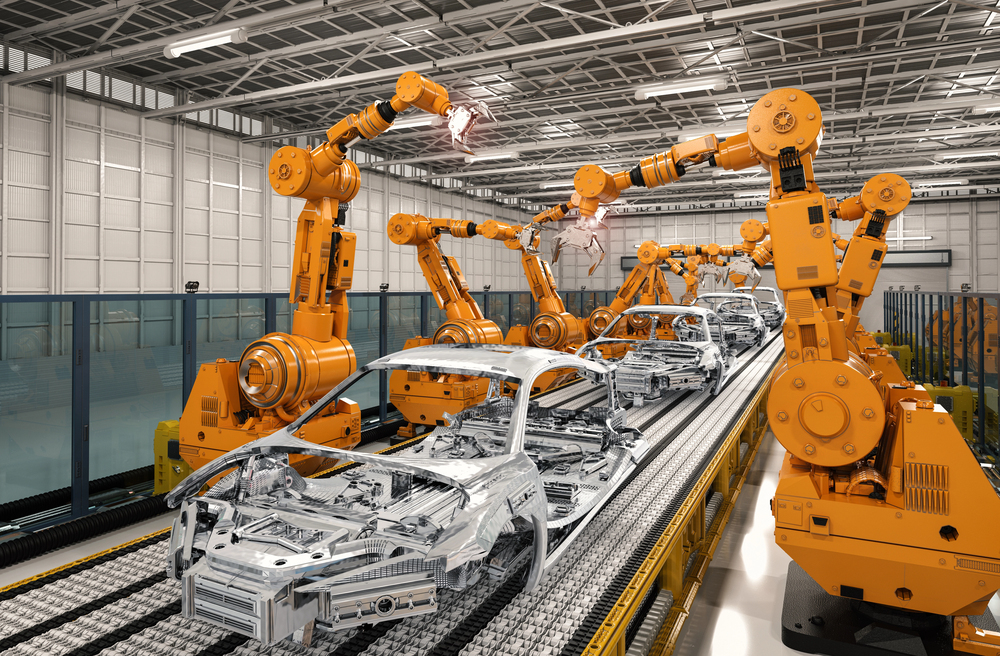Automation has taken over car manufacturing in ways that were unimaginable just a few decades ago. Robots are now assembling vehicles with mind-blowing precision, improving safety, and even making real time decisions on the production line. These 12 shocking facts prove that car manufacturing will never be the same again.
Robots Now Handle Over 50% of Assembly Line Work

Car manufacturers have drastically increased automation, with over half of all assembly processes now handled by robots. These machines work faster, make fewer errors, and never take breaks, making production more efficient than ever before. Automakers rely on them to boost output while maintaining high-quality standards across every vehicle.
AI-Powered Robots Can Detect Flaws Invisible to the Human Eye

Modern robots use advanced artificial intelligence and high-resolution cameras to identify tiny defects in materials and assembly. This technology ensures cars leave the factory with near perfect precision, reducing recalls and warranty claims dramatically. Humans alone could never match this level of accuracy in quality control.
Some Factories Have Almost No Human Workers Anymore

Tesla’s Gigafactories and other state of the art plants have embraced automation so extensively that human workers are becoming rare. Robots now perform welding, painting, assembly, and even logistics, leaving only a handful of specialists to supervise operations. These ultra-modern facilities operate with unmatched efficiency and futuristic precision.
Robot Welders Can Perform Thousands of Spot Welds per Day

Unlike human welders, robotic welding arms can work continuously with pinpoint accuracy, performing thousands of welds per day without error. This allows cars to be assembled with stronger, more consistent joints, increasing safety and structural integrity. The automotive industry now depends on these machines to create durable, crash-resistant vehicles.
Related: 13 SUVs Known for Holding Their Value and Staying on the Road for Over 200,000 Mile
Collaborative Robots Are Working Side by Side with Humans

Unlike traditional industrial robots, new collaborative robots (or “cobots”) are designed to work safely alongside humans. These machines assist with repetitive tasks, lifting heavy components and ensuring greater precision in assembly. Cobots help reduce worker fatigue, improving safety and efficiency in modern car plants.
Related: These 12 Cars Are Appreciating Like Fine Wine – And Why You Should Consider Buying Now
Robots Have Reduced Car Production Time by Over 30%

Manufacturing a vehicle used to take weeks, but robotic automation has slashed production times by more than 30%. Faster welding, precision assembly, and automated quality checks allow factories to produce thousands of vehicles daily. This speed has revolutionized the industry, making cars more affordable and widely available.
Related: SUVs for Seniors: Comfort and Safety Features That Matter Most As You Age
Self-Learning Robots Are Improving Themselves Without Human Help

Advanced AI allows some robots to learn from their mistakes and improve performance over time. By analyzing data in real-time, these machines adjust their techniques to reduce waste, increase accuracy, and work more efficiently. This self-optimization is pushing manufacturing to levels of precision never seen before.
3D Printing Robots Are Building Car Parts in Minutes

Traditional methods of making car parts can take days or weeks, but robotic 3D printers now create components in minutes. Automakers use this technology for rapid prototyping, testing new designs, and even producing custom parts. This innovation is cutting costs and making vehicle production more flexible than ever.
Related: 14 Cars That Make More Sense to Buy Pre-Owned
Painting Robots Use Electrostatic Precision to Reduce Waste

Car painting used to be a messy, time consuming process, but robotic systems now handle it with electrostatic technology. By charging paint particles, robots ensure near-perfect coverage while minimizing overspray and waste. This results in flawless finishes, improved durability, and a more eco-friendly production process.
Related: 13 Car Horns So Loud, They’ll Wake the Entire Neighborhood!
AI-Driven Robots Are Making Cars Safer Than Ever Before

Crash tests and safety improvements once relied on human calculations, but AI-powered robots now analyze and reinforce designs instantly. These machines test materials, improve crumple zones, and adjust manufacturing methods to maximize passenger protection. Thanks to this, modern cars are significantly safer than their predecessors.
Robots Are Assembling EV Batteries with Microscopic Precision

Electric vehicle batteries require extreme precision, and robots are now assembling them with microscopic accuracy. These machines carefully align battery cells, ensuring maximum efficiency and longevity for EVs. Their precision reduces defects, increases performance, and improves the overall reliability of electric vehicles.
Related: Affordable EVs That Actually Go the Distance – 13 Best Picks
Autonomous Robots are Moving Parts Around Factories by Themselves

Factories now use autonomous guided vehicles (AGVs) and robotic arms to transport parts and tools across production lines. These intelligent machines navigate factory floors without human intervention, ensuring seamless, efficient movement of materials. This eliminates human errors, reduces delays, and keeps production running smoothly.
Related: 12 Cheap Electric Cars That Won’t Leave You Stranded
Robots have completely transformed car manufacturing, making it faster, safer, and more precise than ever. From self-learning AI to automated EV assembly, the industry is evolving at an astonishing pace. As automation continues to advance, we may soon see factories where human workers are no longer needed at all. Would you trust a car built entirely by robots?
Disclaimer: This list is solely the author’s opinion based on research and publicly available information.
14 Coolest Car Concepts That Never Made It to Production

Ever wondered what could have been? Automakers have a history of teasing us with jaw dropping concept cars, only to lock them away or worse, scrap them entirely. These futuristic and often insane vehicles showcased cutting edge design and tech but never made it to production. From supercars that could have redefined performance to luxury sedans promising next level comfort, here are 14 concept cars that were just too cool for the road.
Read it here: 14 Coolest Car Concepts That Never Made It to Production
15 Futuristic Car Innovations That Prove Tesla Is Playing a Different Game

The automotive world has seen some jaw dropping innovations over the years, but few have shaken up the industry quite like Tesla’s Cybertruck. Love it or hate it, this futuristic beast has redefined expectations, pushing boundaries in design, technology, and performance. But Tesla isn’t alone automakers worldwide have introduced game changing advancements that are making cars smarter, safer, and more efficient. Here are 15 of the most mind-blowing car innovations, including the ones that helped make Tesla’s Cybertruck an unstoppable force.
Read it here: 15 Futuristic Car Innovations That Prove Tesla Is Playing a Different Game
15 Car Features That Are a Complete Waste of Money

When buying a car, it’s easy to get tempted by high-tech upgrades and luxury add-ons. However, not all features are worth the extra cost, some are gimmicks, others become outdated quickly, and a few are just plain unnecessary. Before you splurge on these so-called “upgrades,” take a closer look at what you’re really paying for. These features may seem appealing at first, but they often add little value in everyday driving. These car features often turn out to be a complete waste of money.
Read it here: 15 Car Features That Are a Complete Waste of Money
You’ll love these related posts:


